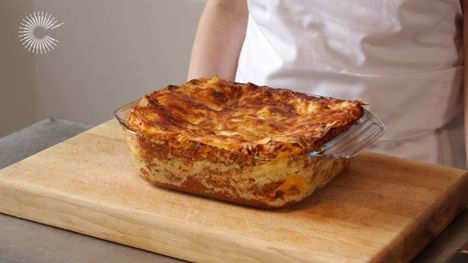Italian food at its comforting best, lasagne is a dish cooked ‘al forno’ (in the oven). While there are a few steps to the process of making the dish, it is relatively straightforward to put together once you know how to cook and assemble the different elements. Follow our guide and you’ll be making it like a pro every time.
What are the main ingredients in lasagne?
The classic image we most associate with the dish is ‘lasagne alla Bolognese’ which is made with Bolognese ragu sauce. This is traditionally made with a mix of pork and beef mince, that is cooked down for hours until rich and flavoursome. The ragu is then layered with ‘bechamel’ or white sauce and pasta sheets before being cooked until golden and bubbling.
Is there a correct order for layering a lasagne?
There is some debate over this, but generally most chefs use a little of the meat sauce in the base of the oven dish first, then top this with a single layer of pasta sheets, followed by a layer of meat sauce then a layer of bechamel. This is then repeated until you reach the final layer, which should be pasta sheets, followed by bechamel and grated Parmesan to top.
How do you make a classic meat ragu sauce?
The traditional way to do this is by cooking a soffrito mix (so onion, carrot and celery) very gently until soft, before adding tomato paste, red wine and browned beef and pork mince and simmering for several hours. For a classic ragu, milk is added for the final 30-40 minutes of cooking time which works to both balance the flavours in the sauce and tenderise the meat. Try Filippo Trapella’s family recipe for a real Italian homemade lasagne.
What is the best way to make bechamel?
This roux-based sauce is an integral part of your lasagne and is different from a basic roux as the milk is infused with onion, bay and mace. This warm mixture is then stirred into a cooked flour and butter roux. Worried about lumps? The key to keeping your sauce smooth is to add the milk a little at a time, stirring constantly. Follow our method for great results.
Once you have your ragu sauce and bechamel made up, you are ready to make you lasagne in a matter of a few easy steps:
Metric
Imperial
- 750g of beef ragu
- 500ml of bechamel sauce
- 0 fresh lasagne sheet
- 50g of Parmesan
Heat the oven to 200C/180C. Ladle a little of the ragu into the base of a baking dish, spreading it into an even layer
- 750g of beef ragu
Arrange 2 lasagne sheets over the top of the sauce. Spoon over a layer of white sauce then spoon over a good layer of the ragu and then the lasagne sheets. Repeat again, finishing with a layer of bechamel over the final layer of pasta, then grate the Parmesan over.
Bake in the oven for 40-50 minutes until tender and cooked through, and golden on top.
Do you need to boil the pasta sheets before layering up lasagne?
This depends on the kind of pasta you are using. If you are going with homemade pasta or fresh lasagne sheets, then there is no need to pre-cook these. If you are using ‘no-cook’ lasagne sheets the same is also true and you can layer these straight into the dish. However check your pack if you are using dried pasta sheets as some do require gently simmering for a few mins before use.
What flavours can I use in lasagne?
There’s no real limit to the flavours that can be used in lasagne. While the classic contains meat ragu and bechamel, there are versions with seafood and crab, spinach and ricotta and veggie lasagnes with earthy mushrooms and lentils. Check out our collection for inspiration
Can you cook lasagne in the slow cooker?
Cooking your lasagne in a slow cooker can give soft and delicious results, although you won’t get the same crispy burnished edges as you might in the oven. To cook your lasagne this way you still need to make the ragu and white sauce in separate pans first, as you would with a normal lasagne. Then you can layer up your lasagne in your slow cooker, following the same ordering as you would in a baking dish, and cook on low for around 5 hours until tender.
Is it ok to freeze lasagne?
Yes, lasagnes of all varieties, both meat and veggie, freeze really well. This makes them perfect for making ahead, or batch cooking – whip up one and make a second at the same time to pop in the freezer. You can fully cook your lasagne in the oven, then allow it to cool, wrap really well in and freeze in its baking dish for up to 3 months. But for the best results layer up with the filling, sauce and pasta (no-cook sheets are best for this method), then wrap and chill at this stage. Allow it to defrost fully before baking then put in the oven following the original recipe’s timings. Or you can cook your lasagne straight from frozen for about 2 hours in a low oven, until piping hot, cooked through and bubbling.
Get in touch
Please sign in or register to send a comment to Great British Chefs.



